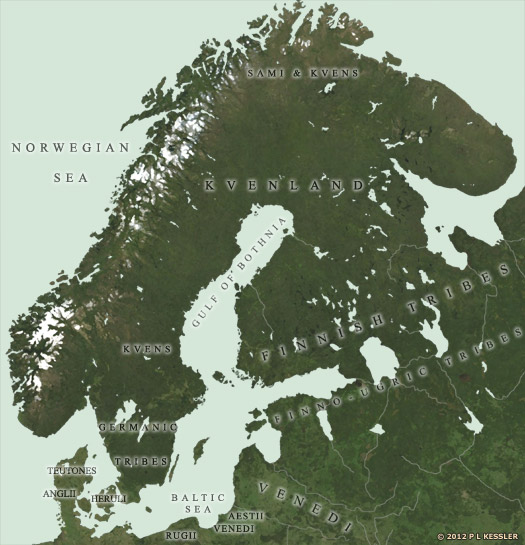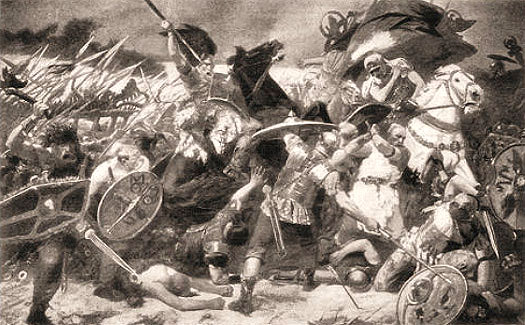Kingdoms of the Germanic Tribes - Naristi / Varisci (original) (raw)
Naristi / Varisci / Varisti (Suevi) In the first century AD, vast areas of central, northern, andEastern Europe were dark and unknown lands full of savage Germanic barbarians - at least according to the Romans. Little detail is known about many of those savage Germanic barbarians, but brief windows are opened onto their lives and organisation at various points during the existence of the Roman empire in Europe, while other Germanic groups went on to play major roles in the extinction of that empire.  The Indo-European Germanic ethnic group began as a division of the western edge of late proto-Indo-European dialects around 3300 BC. This particular division migrated as part of the Yamnaya horizon to reach the southern coastline of the Early Baltics, seemingly as part of the territorially-extensive Corded Ware culture. From there, over the course of a millennium or more, elements of them entered southern Scandinavia (see feature link for more detail). The Indo-European Germanic ethnic group began as a division of the western edge of late proto-Indo-European dialects around 3300 BC. This particular division migrated as part of the Yamnaya horizon to reach the southern coastline of the Early Baltics, seemingly as part of the territorially-extensive Corded Ware culture. From there, over the course of a millennium or more, elements of them entered southern Scandinavia (see feature link for more detail).  By the time in which Germanic tribes were becoming key players in Western European politics in the last two centuries BC, the previously dominant Celts were on the verge of being conquered by Rome (see map link for general tribal locations). Strabo says that the Romans introduced the name 'Germani' for these 'new' barbarians because their tribes were the 'authentic Celts', seeming to mean that they were what the Celts used to be - strong, aggressive, and bold. Once they had begun to migrate southwards out of Northern Europe's farther reaches, Germanic tribes carved out homelands between the Rhine and the Pripet Marshes (modern Belarus). They slowly consolidated their positions (although migrations still occurred) until they had formed tribal kingdoms which eventually threatened the Roman empire itself. This threat became bloody reality when many were forced west and south by later incursions of Hunnic tribes into their lands which caused tribal fractures and a degree of scattered relocation. The Naristi (variously also attested as Varisci and Varisiti) were attested by several Greek and Roman authors. Tacitus refers to them in his first century AD work, Germania as Naristi. The later work, Historia Augusta, refers to them as Varistae (or Varisti). Both mentions are usually regarded by modern scholars as being authentic and to refer to the same individual tribe, but the interpretation of their ethnonym is controversial. Tacitus certainly considered them to be Germans, but perhaps later interactions (probably with relics of Danubian Celtic tribes) served to introduce some doubt. Proto-Celtic (reconstructed) has 'nero-', meaning 'hero', so perhaps the tribe's name comes from that. A precise settlement location for the tribe is uncertain. They seem to have been located within the vicinity of the Marcomanni and Quadi, to the north-west of the Gabreta Silva, today's Bohemian Forest, and close to the upper Danube. They are considered to be one of the oldest tribes to be known by name in today's Bavarian Nordgau region. According to the Tabula Peutingeriana, the Narisci lived in the Vils and Naab valleys, between today's Amberg, Weide, and Kallmünz (Oberpfalz), and all within the vicinity of Castra Regina (today's Regensburg), which they attacked during the Marcomannic Wars of the mid-second century AD. In 1863, urns with human remains and jewellery which have been attributed to the Naristi were found in Schwandorf, with further finds coming from Oberpfalz and around the River Naab. Cassius Dio reports that three thousand Naristi defected to Rome and received land in return (Dio 71:21). After that the Naristi name disappears from history, although the tribe survived as a recognisable entity into the mid-third century. One thesis which was put forward in older research and which stated that some Naristi were settled in fourth century Burgundy cannot be proven. According to the Tabula Peutingeriana, the town of Hof (Oberfranken - Upper Franconia in the north-eastern corner of Bavaria) was first mentioned as Curia Variscorum, court of the German Varisci in the fourth century. By the time in which Germanic tribes were becoming key players in Western European politics in the last two centuries BC, the previously dominant Celts were on the verge of being conquered by Rome (see map link for general tribal locations). Strabo says that the Romans introduced the name 'Germani' for these 'new' barbarians because their tribes were the 'authentic Celts', seeming to mean that they were what the Celts used to be - strong, aggressive, and bold. Once they had begun to migrate southwards out of Northern Europe's farther reaches, Germanic tribes carved out homelands between the Rhine and the Pripet Marshes (modern Belarus). They slowly consolidated their positions (although migrations still occurred) until they had formed tribal kingdoms which eventually threatened the Roman empire itself. This threat became bloody reality when many were forced west and south by later incursions of Hunnic tribes into their lands which caused tribal fractures and a degree of scattered relocation. The Naristi (variously also attested as Varisci and Varisiti) were attested by several Greek and Roman authors. Tacitus refers to them in his first century AD work, Germania as Naristi. The later work, Historia Augusta, refers to them as Varistae (or Varisti). Both mentions are usually regarded by modern scholars as being authentic and to refer to the same individual tribe, but the interpretation of their ethnonym is controversial. Tacitus certainly considered them to be Germans, but perhaps later interactions (probably with relics of Danubian Celtic tribes) served to introduce some doubt. Proto-Celtic (reconstructed) has 'nero-', meaning 'hero', so perhaps the tribe's name comes from that. A precise settlement location for the tribe is uncertain. They seem to have been located within the vicinity of the Marcomanni and Quadi, to the north-west of the Gabreta Silva, today's Bohemian Forest, and close to the upper Danube. They are considered to be one of the oldest tribes to be known by name in today's Bavarian Nordgau region. According to the Tabula Peutingeriana, the Narisci lived in the Vils and Naab valleys, between today's Amberg, Weide, and Kallmünz (Oberpfalz), and all within the vicinity of Castra Regina (today's Regensburg), which they attacked during the Marcomannic Wars of the mid-second century AD. In 1863, urns with human remains and jewellery which have been attributed to the Naristi were found in Schwandorf, with further finds coming from Oberpfalz and around the River Naab. Cassius Dio reports that three thousand Naristi defected to Rome and received land in return (Dio 71:21). After that the Naristi name disappears from history, although the tribe survived as a recognisable entity into the mid-third century. One thesis which was put forward in older research and which stated that some Naristi were settled in fourth century Burgundy cannot be proven. According to the Tabula Peutingeriana, the town of Hof (Oberfranken - Upper Franconia in the north-eastern corner of Bavaria) was first mentioned as Curia Variscorum, court of the German Varisci in the fourth century. |
|
|---|---|
 |
|
| (Information by Trish Wilson, with additional information by Peter Kessler and Edward Dawson, from Power and Status in the Roman Empire, AD 193-284, Inge Mennen, from Germania, Tacitus, from Agricola, from The Harleian Miscellany: A Collection of Scarce, Curious and Entertaining Tracts Volume 4, William Oldys & Thomas Park, from Roman Soldier versus Germanic Warrior: 1st Century AD, Lindsay Powell, from The Horse, the Wheel, and Language: How Bronze-Age Riders from the Eurasian Steppes Shaped the Modern World, David W Anthony, from Atlas historique mondial, Georges Duby (Larousse, 1978), from Geography, Ptolemy, and from External Links: The Works of Julius Caesar: Gallic Wars, and Polybius, Histories, and Geography, Strabo (H C Hamilton & W Falconer, London, 1903, Perseus Online Edition).) | |
| 98 | Writing around this time, the [Roman](ItalyRomeEmpire.htm#Adoptive Emperors) writer Tacitus mentions the Suevi, listing their constituent tribes which cover the larger part of Germania. Noted for their custom of twisting their hair and binding it up in a knot, the Buri live close to the Marsigni, eastwards of three tribes along the Danube, the Marcomanni, Naristi, and Quadi.  Early Germanic peoples in Scandinavia were clustered for the most part along the coasts of southern Scandinavia, and only began to expand inland from around the third century AD or so (click or tap on map to view full sized) Early Germanic peoples in Scandinavia were clustered for the most part along the coasts of southern Scandinavia, and only began to expand inland from around the third century AD or so (click or tap on map to view full sized) |
| 166 - 169 | A new Marcomanni confederation is formed which also includes elements from many other tribes including the Buri, Iazyges, Naristi, Quadi, Sarmatians, and Suebi. The Marcomannic Wars are underway. Under the leadership of Ballomar of the Marcomanni, they cross the Danube and invade Dacia. They penetrate as far as Italy, forcing the [Roman](ItalyRomeEmpire.htm#Adoptive Emperors) emperor, Marcus Aurelius, to spend the rest of his life campaigning in the Danube region to contain the problem. This he does (to an extent) with a further defeat of them in 180, near the Roman castra of Vindobona on the Germanic limes in Pannonia (today's Vienna in Austria, with the final battle being shown impressively in the opening scenes of the film, Gladiator, 2000). |
| 254 | By this time, the Suevi have formed a wide-ranging confederation of tribes which are all known individually but which are counted as being Suevi.  The main bodies of the Vandali, Alani, and Suevi tribes crossed the Rhine at the end of 406, resulting in panic and chaos within the Roman empire The main bodies of the Vandali, Alani, and Suevi tribes crossed the Rhine at the end of 406, resulting in panic and chaos within the Roman empire |
| The vast number of tribes included in the confederation include the Aestii, Angles, Aviones, Buri, Cotini, Eudoses, Gutones, Hermunduri (who have virtually ceased to exist as a recognisable independent people), Langobards, Lugii (a name applied to several tribes: the Harii, Helisii, Helveconae, Manimi, and Naharvali), Marcomanni, Marsigni, Naristi, Nuitones, Osi, Quadi, Reudigni, Semnones, Sitones, Suardones, Suiones (Swedes), and the Warini. | |
 |